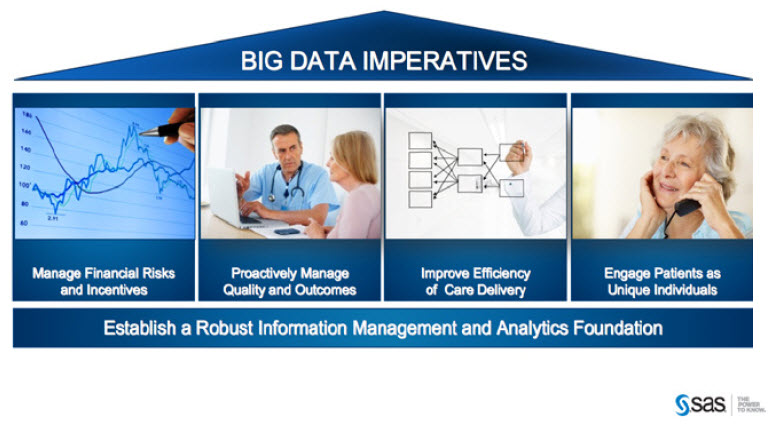Embracing Big Data: Five Strategic Imperatives You Must Address
Commentary by Dr. Graham Hughes, Chief Medical Officer, SAS Center for Health Analytics and Insights

The Opportunity
When healthcare historians reflect on the
current decade, there is little doubt it will
be documented as a pivotal era in our
nation’s history. Whichever way you look
at it, PPACA and HITECH have created an
unprecedented opportunity for data-fueled
healthcare transformation.
Of course, some will try to maintain the
status quo, but those who have chosen to
seize the opportunity are developing multi-year
road maps to address the following five
imperatives:
- Manage financial risks and incentives
associated with emerging payment
models
- Proactively manage quality and outcomes,
rather than just report on quality
measures after the fact
- Improve efficiency of care delivery by
identifying and eliminating waste
- Engage patients as unique individuals
to anticipate and respond proactively to
their health needs
- Establish a robust information management
and analytics foundation that
treats enterprise data as an essential
asset that supports organizational
excellence
The Challenge
The majority of organizations are inadequately
prepared for the new era of
accountability being fueled by healthcare
reform. Their digital infrastructures are
focused on supporting transactions rather
than transformation, while data remains
siloed and chaotic, not synthesized and
curated. To make well-informed, data-driven
decisions, the current and emerging enterprise
data needs to be managed effectively.
As the focus shifts to a broader view of the
health needs of both the individual and the
population, traditionally distinct data sets
(such as claims data and clinical data) will
need to be brought together. Couple this
with the opportunity to use emerging and
nontraditional data sets, such as those captured
by digital home monitoring, health 2.0,
social media apps, and consumer-related
data that has been used for years in other
industries, and the opportunity quickly
begins to look like an overwhelming “big
data” challenge.
The Solution
It helps if you have the right analytics
technology to support each stage of organizational
growth, from visual exploration and
reporting to forecasting, predictive modeling,
optimization, and point-of-care workflow
integration. However, there are some key
indicators of success to keep in mind: the
level of C-suite support, tight alignment with
top-level business strategy, a focus on frontline
value at the point of care, and a clearly
articulated approach to each of the imperatives
outlined above.
Consider the following questions as you continue
to refine your analytics strategy:
- How will we perform under one or more
value-based payment contracts? How
is that likely to evolve over the next five
years?
- How can we optimize both revenue and
margin, based on multiple, potentially
conflicting contract payment models?
- Where are the greatest areas of variation
for both care and cost? What’s behind
that variation?
- How does our performance compare
both regionally and nationally?
- What patterns do we see in readmissions
that can lead to successful interventions?
- How well do we predict the risk of complications,
length of stay, or readmission
for individual patients—and how do we
disseminate that information to care
teams?
- What do we know about the level of risk
in the populations we serve today and in
the future?
- What interventions are most effective at
engaging specifically targeted cohorts of
patients?
- What data do we need to improve care
and control costs?
- What is our strategic approach to information
governance, security, and data
quality?
Answers to these questions will help you
start necessary conversations about analytic
imperatives within your organization. Plus,
you’ll be able to assess how far along you
are on your journey from a reactive to a predictive
healthcare organization—one that’s
fully prepared for success in this new era.